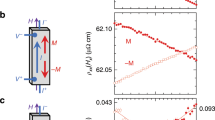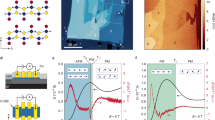Abstract
Recent discoveries of large magnetoresistance in non-magnetic semiconductors1,2,3,4,5,6,7,8 have gained much attention because the size of the effect is comparable to, or even larger than, that of magnetoresistance in magnetic systems9,10,11,12,13,14. Conventional magnetoresistance in doped semiconductors is straightforwardly explained as the effect of the Lorentz force on the carrier motion15, but the reported unusually large effects imply that the underlying mechanisms have not yet been fully explored. Here we report that a simple device, based on a lightly doped silicon substrate between two metallic contacts, shows a large positive magnetoresistance of more than 1,000 per cent at room temperature (300 K) and 10,000 per cent at 25 K, for magnetic fields between 0 and 3 T. A high electric field is applied to the device, so that conduction is space-charge limited16,17,18. For substrates with a charge carrier density below ∼1013 cm-3, the magnetoresistance exhibits a linear dependence on the magnetic field between 3 and 9 T. We propose that the observed large magnetoresistance can be explained by quasi-neutrality breaking of the space-charge effect, where insufficient charge is present to compensate the electrons injected into the device. This introduces an electric field inhomogeneity, analogous to the situation in other semiconductors in which a large, non-saturating magnetoresistance was observed1,2,3,4,5,19. In this regime, the motions of electrons become correlated, and thus become dependent on magnetic field. Although large positive magnetoresistance at room temperature has been achieved in metal–semiconductor hybrid devices6,7,8, we have now realized it in a simpler structure and in a way different from other known magnetoresistive effects9,10,11,12,13,14,20. It could be used to develop new magnetic devices from silicon, which may further advance silicon technology.
This is a preview of subscription content, access via your institution
Access options
Subscribe to this journal
Receive 51 print issues and online access
$199.00 per year
only $3.90 per issue
Buy this article
- Purchase on Springer Link
- Instant access to full article PDF
Prices may be subject to local taxes which are calculated during checkout




Similar content being viewed by others
References
Xu, R. et al. Large magnetoresistance in non-magnetic silver chalcogenides. Nature 390, 57–60 (1997)
Husmann, A. et al. Megagauss sensors. Nature 417, 421–424 (2002)
Parish, M. M. & Littlewood, P. B. Non-saturating magnetoresistance in heavily disordered semiconductors. Nature 426, 162–165 (2003)
Parish, M. M. & Littlewood, P. B. Classical magnetotransport of inhomogeneous conductors. Phys. Rev. B 72, 094417 (2005)
Zhang, T. et al. Tuning the inherent magnetoresistance of InSb thin films. Appl. Phys. Lett. 88, 012110 (2006)
Solin, S. A., Thio, T., Hines, D. R. & Heremans, J. J. Enhanced room-temperature geometric magnetoresistance in inhomogeneous narrow-gap semiconductor. Science 289, 1530–1532 (2000)
Moussa, J. et al. Finite-element modelling of extraordinary magnetoresistance in thin film semiconductors with metallic inclusions. Phys. Rev. B 64, 184410 (2001)
Solin, S. A. et al. Nonmagnetic semiconductors as read-head sensors for ultra-high-density magnetic recording. Appl. Phys. Lett. 80, 4012–4014 (2002)
Baibich, M. N. et al. Giant magnetoresistance of Fe(001)/(001) Cr magnetic superlattices. Phys. Rev. Lett. 61, 2472–2475 (1988)
Berkowitz, A. E. et al. Giant magnetoresistance in heterogeneous Cu-Co alloys. Phys. Rev. Lett. 68, 3745–3748 (1992)
Xiao, J. Q., Jiang, J. & Chien, C. L. Giant magnetoresistance in nonmultilayer magnetic systems. Phys. Rev. Lett. 68, 3749–3752 (1992)
Jin, S. et al. Thousandfold change in resistivity in magnetoresistive La-Ca-Mn-O films. Science 264, 413–415 (1994)
Yuasa, S. et al. Giant room-temperature magnetoresistance in single-crystal Fe/MgO/Fe magnetic tunnel junctions. Nature Mater. 3, 868–871 (2004)
Parkin, S. S. P. et al. Giant tunnelling magnetoresistance at room temperature with MgO (100) tunnel barriers. Nature Mater. 3, 862–867 (2004)
Ashcroft, N. W. & Mermin, N. D. Solid State Physics (Holt, Rinehart and Winston, 1976)
Sze, S. M. & Ng, K. K. Physics of Semiconductor Devices 3rd edn (Wiley, 2007)
Rose, A. Space-charge-limited currents in solids. Phys. Rev. 97, 1538–1544 (1955)
Lampert, M. A. Simplified theory of space-charge-limited currents in an insulator with traps. Phys. Rev. 103, 1648–1656 (1956)
Herring, C. Effect of random inhomogeneities on electrical and galvanomagnetic measurements. J. Appl. Phys. 31, 1939–1953 (1960)
Sun, Z. G., Mizuguchi, M., Manago, T. & Akinaga, H. Magnetic-field-controllable avalanche breakdown and giant magnetoresistive effects in Gold/semi-insulating GaAs Schottky diode. Appl. Phys. Lett. 85, 5643–5645 (2004)
Payling, C. A. et al. Electric field-induced quasi-elastic inter-Landau level scattering in the space-charge-limited magnetoconductivity of n+n-n+ InP structures. Superlatt. Microstruct. 2, 415–419 (1986)
Yafet, Y., Keyes, R. W. & Adams, E. N. Hydrogen atom in a strong magnetic field. J. Phys. Chem. Solids 1, 137–142 (1956)
Sladek, R. J. Magnetically induced impurity banding in n-InSb. J. Phys. Chem. Solids 5, 157–170 (1958)
Shklovskii, B. I. & Efros, A. L. Electronic Properties of Doped Semiconductors (Springer, 1984)
Sampsell, J. B. & Garland, J. C. Current distortion effects and linear magnetoresistance of inclusions in free-electron metals. Phys. Rev. B 13, 583–589 (1976)
Stroud, D. & Pan, F. P. Effect of isolated inhomogeneities on the galvanomagnetic properties of solids. Phys. Rev. B 13, 1434–1438 (1976)
Bergman, D. J. & Stroud, D. G. High-field magnetotransport in composite conductors: Effective medium approximation. Phys. Rev. B 62, 6603–6613 (2000)
Tornow, M., Weiss, D., v, Klitzing, K. & Eberl, K. Anisotropic magnetoresistance of a classical antidot array. Phys. Rev. Lett. 77, 147–150 (1996)
Lampert, M. A. & Rose, A. Volume-controlled, two-carrier currents in solids: The injected plasma case. Phys. Rev. 121, 26–37 (1961)
Schoonus, J. J. H. M., Bloom, F. L., Wagemans, W., Swagten, H. J. M. & Koopmans, B. Extremely large magnetoresistance in boron-doped silicon. Phys. Rev. Lett. 100, 127202 (2008)
Acknowledgements
We appreciate discussions with T. Shinjo, H. Akinaga, H. Sakakima, Y. Iye, J. Ohe, S. Takahashi and T. Susaki. This work was partly supported by KAKENHI, ICR Grants for Young Scientists, the Asahi Glass Foundation and the Sumitomo Foundation. M.P.D. acknowledges support from JSPS Research Fellowships for Young Scientists.
Author information
Authors and Affiliations
Corresponding author
Supplementary information
Supplementary Figures
This file contains Supplementary Figures S1-S4 with Legends (PDF 618 kb)
Rights and permissions
About this article
Cite this article
Delmo, M., Yamamoto, S., Kasai, S. et al. Large positive magnetoresistive effect in silicon induced by the space-charge effect. Nature 457, 1112–1115 (2009). https://doi.org/10.1038/nature07711
Received:
Accepted:
Issue Date:
DOI: https://doi.org/10.1038/nature07711
This article is cited by
-
Analysis of Surface Current by Quantum Tunneling Effect of Thin Film Transistors with Topological Insulators
Scientific Reports (2020)
-
Electron spin relaxations of phosphorus donors in bulk silicon under large electric field
Scientific Reports (2019)
-
The space charge limited current and huge linear magnetoresistance in silicon
Scientific Reports (2018)
-
Voltage-Controlled Magnetoresistance in Silicon Nanowire Transistors
Scientific Reports (2018)
-
Room temperature magneto-optic effect in silicon light-emitting diodes
Nature Communications (2018)
Comments
By submitting a comment you agree to abide by our Terms and Community Guidelines. If you find something abusive or that does not comply with our terms or guidelines please flag it as inappropriate.



